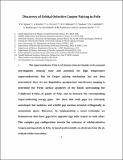Files in this item
Discovery of orbital-selective Cooper pairing in FeSe
Item metadata
| dc.contributor.author | Sprau, Peter O. | |
| dc.contributor.author | Kostin, Andrey | |
| dc.contributor.author | Kreisel, Andreas | |
| dc.contributor.author | Böhmer, Anna E. | |
| dc.contributor.author | Taufour, Valentin | |
| dc.contributor.author | Canfield, Paul C. | |
| dc.contributor.author | Mukherjee, Shantanu | |
| dc.contributor.author | Hirschfeld, Peter J. | |
| dc.contributor.author | Andersen, Brian M. | |
| dc.contributor.author | Davis, J. C. Séamus | |
| dc.date.accessioned | 2018-01-18T15:30:09Z | |
| dc.date.available | 2018-01-18T15:30:09Z | |
| dc.date.issued | 2017-07-07 | |
| dc.identifier | 252088171 | |
| dc.identifier | 3613f9be-7768-4da4-8458-f0076408f2b6 | |
| dc.identifier | 85024104320 | |
| dc.identifier | 000416909500005 | |
| dc.identifier.citation | Sprau , P O , Kostin , A , Kreisel , A , Böhmer , A E , Taufour , V , Canfield , P C , Mukherjee , S , Hirschfeld , P J , Andersen , B M & Davis , J C S 2017 , ' Discovery of orbital-selective Cooper pairing in FeSe ' , Science , vol. 357 , no. 6346 , pp. 75-80 . https://doi.org/10.1126/science.aal1575 | en |
| dc.identifier.issn | 0036-8075 | |
| dc.identifier.other | ArXiv: http://arxiv.org/abs/1611.02134v2 | |
| dc.identifier.uri | https://hdl.handle.net/10023/12509 | |
| dc.description | For movie S1, see http://www.physik.uni-leipzig.de/~kreisel/oscp/S1.mp4, for movie S2, see http://www.physik.uni-leipzig.de/~kreisel/oscp/S2.mp4 and for movie S3, see http://www.physik.uni-leipzig.de/~kreisel/oscp/S3.mp4 Funding: Moore Foundation’s EPiQS Initiative through Grant GBMF4544 (JCSD) | en |
| dc.description.abstract | The superconductor iron selenide (FeSe) is of intense interest owing to its unusual nonmagnetic nematic state and potential for high-temperature superconductivity. But its Cooper pairing mechanism has not been determined. We used Bogoliubov quasiparticle interference imaging to determine the Fermi surface geometry of the electronic bands surrounding the Γ = (0, 0) and X = (π/aFe, 0) points of FeSe and to measure the corresponding superconducting energy gaps. We show that both gaps are extremely anisotropic but nodeless and that they exhibit gap maxima oriented orthogonally in momentum space. Moreover, by implementing a novel technique, we demonstrate that these gaps have opposite sign with respect to each other. This complex gap configuration reveals the existence of orbital-selective Cooper pairing that, in FeSe, is based preferentially on electrons from the dyz orbitals of the iron atoms. | |
| dc.format.extent | 6102981 | |
| dc.language.iso | eng | |
| dc.relation.ispartof | Science | en |
| dc.subject | QC Physics | en |
| dc.subject | QD Chemistry | en |
| dc.subject | T Technology | en |
| dc.subject | T-NDAS | en |
| dc.subject | BDC | en |
| dc.subject | R2C | en |
| dc.subject.lcc | QC | en |
| dc.subject.lcc | QD | en |
| dc.subject.lcc | T | en |
| dc.title | Discovery of orbital-selective Cooper pairing in FeSe | en |
| dc.type | Journal article | en |
| dc.contributor.sponsor | EPSRC | en |
| dc.contributor.institution | University of St Andrews. School of Physics and Astronomy | en |
| dc.contributor.institution | University of St Andrews. Condensed Matter Physics | en |
| dc.identifier.doi | 10.1126/science.aal1575 | |
| dc.description.status | Peer reviewed | en |
| dc.identifier.url | http://arxiv.org/abs/1611.02134v2 | en |
| dc.identifier.grantnumber | EP/I031014/1 | en |
This item appears in the following Collection(s)
Items in the St Andrews Research Repository are protected by copyright, with all rights reserved, unless otherwise indicated.

